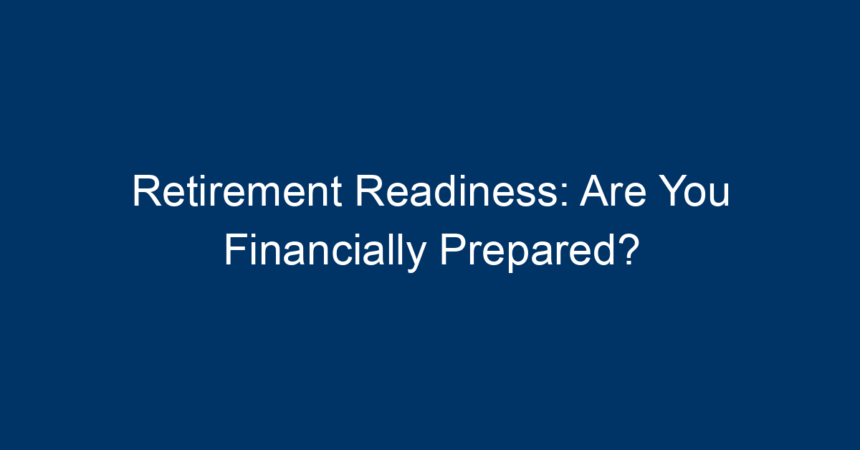As the years fly by, the question of retirement readiness becomes increasingly crucial. Many people dream of a stress-free retirement filled with travel, relaxation, and time with loved ones, yet few take the necessary steps to ensure that dream becomes a reality. Whether you’re in your 30s, 40s, or nearing retirement age, understanding your financial preparedness is essential. This comprehensive guide will delve into the factors that contribute to retirement readiness, helping you assess your own financial situation and make informed decisions for the future.
What is Retirement Readiness?
Retirement readiness refers to the state of being financially prepared to retire comfortably. This includes having sufficient savings, investments, and a plan to cover living expenses for the duration of your retirement years. The goal is to ensure that you can maintain your desired lifestyle without being overly concerned about money.
The Importance of Early Planning
Retirement readiness isn’t an overnight project; it requires early and consistent planning. The earlier you start saving for retirement, the more time your money has to grow. Thanks to the wonders of compound interest, even small contributions can accumulate into significant savings over time. By prioritizing your retirement planning, you can give yourself the gift of ease and security in your later years.
Assessing Your Current Financial Situation
To determine your retirement readiness, you must first evaluate where you currently stand financially. Here are the essential areas to consider:
1. Income and Expenses
Begin by taking a close look at your current income and expenses. Understanding your cash flow will help you identify how much you can save for retirement each month.
- Track Your Spending: Use budgeting apps or spreadsheets to categorize your expenses. Identify areas where you can cut back.
- Calculate Net Income: Assess your monthly income after taxes and other deductions. This gives you a clearer picture of your available funds.
2. Current Savings and Investments
Next, examine your savings and investment accounts. This includes:
- Retirement Accounts: Assess your contributions to 401(k)s, IRAs, or other retirement plans. Are you maximizing employer contributions?
- Emergency Fund: It’s essential to have a safety net for unexpected expenses, but ensure this doesn’t come at the expense of your retirement savings.
3. Debt Management
Your outstanding debts can significantly impact your retirement readiness. Prioritize paying off high-interest debt to free up more money for retirement savings. Consider:
- Debt-to-Income Ratio: A lower ratio improves your financial stability.
- Debt Repayment Strategies: Use methods like the avalanche or snowball approach to tackle debts systematically.
Setting Retirement Goals
Once you’ve assessed your current financial situation, the next step toward retirement readiness is setting specific goals.
1. Define Your Retirement Lifestyle
What kind of lifestyle do you envision in retirement? Consider the following:
- Travel Plans: Do you dream of visiting new countries or spending winters in warmer climates?
- Hobbies and Activities: What activities do you plan to pursue? Factor in any associated costs.
2. Estimate Future Expenses
Based on your envisioned lifestyle, estimate your future monthly expenses. Consider:
- Housing Costs: Will you downsize, relocate, or stay in your current home?
- Healthcare: As you age, healthcare will become a more significant expense. Plan accordingly.
- Inflation: Remember to factor in inflation, which could alter the purchasing power of your savings.
3. Determine Your Savings Target
Once you have a clearer idea of your desired retirement lifestyle and its associated costs, you can calculate how much you’ll need to save. Financial advisors often recommend aiming for a retirement income that replaces about 70-80% of your pre-retirement income.
Retirement Accounts and Savings Vehicles
To achieve your savings target, you’ll need to choose the right retirement accounts and savings vehicles. Here’s a breakdown:
1. Employer-Sponsored Retirement Plans
- 401(k) and 403(b) Plans: These tax-advantaged accounts often come with employer matching. If available, contribute enough to take full advantage of the match.
2. Individual Retirement Accounts (IRAs)
- Traditional IRA: Contributions may be tax-deductible, and you’ll pay taxes on withdrawals in retirement.
- Roth IRA: Contributions are made with after-tax income, but withdrawals in retirement are tax-free.
3. Other Investment Options
- Real Estate: Rental properties can provide an income stream during retirement, but they require upfront investment and ongoing management.
- Stocks and Bonds: Diversify your investment portfolio to balance risk and return. Consider speaking with a financial advisor to create a personalized investment strategy.
Creating a Retirement Plan
With your financial situation, goals, and accounts in mind, it’s time to devise a comprehensive retirement plan:
1. Develop a Savings Strategy
- Automate Contributions: Set up automatic transfers to your retirement accounts to simplify the saving process.
- Increase Savings Over Time: As your income grows, gradually increase your contributions to accelerate your savings.
2. Reevaluate and Adjust
- Annual Reviews: Regularly review your retirement plan to adapt to changes in your financial situation or personal goals.
- Market Conditions: Stay informed on economic trends that could affect your investments.
Additional Considerations for Retirement Readiness
In addition to financial planning, ensure you’re prepared for other aspects of retirement:
1. Social Security
Understand your benefits and when to begin taking them. Waiting until full retirement age or even later can significantly increase your benefits.
2. Healthcare Coverage
- Medicare: Research eligibility and coverage during your planning.
- Long-Term Care Insurance: Consider investing in this to cover potential future healthcare costs.
3. Estate Planning
Ensure you have an updated will, power of attorney, and healthcare proxy in place. This safeguards your assets and outlines your wishes for care and distribution.
Conclusion: Taking Action Toward Retirement Readiness
Retirement readiness goes beyond just savings—it’s about envisioning your future and taking actionable steps to turn that vision into reality. By actively assessing your financial situation, setting clear goals, and implementing a robust retirement plan, you can feel confident in your financial preparedness for the years ahead.
Remember to stay engaged with your retirement planning, as life circumstances and economic conditions may change. Ultimately, the earlier you start preparing for retirement, the more options you will have when it comes time to enjoy it. Begin today by assessing your readiness, and take the necessary steps to secure the retirement you desire.
By embracing these strategies and staying informed, you can navigate the complexities of retirement planning with confidence and clarity, ensuring not just retirement readiness, but a fulfilling and joyful retirement experience.




